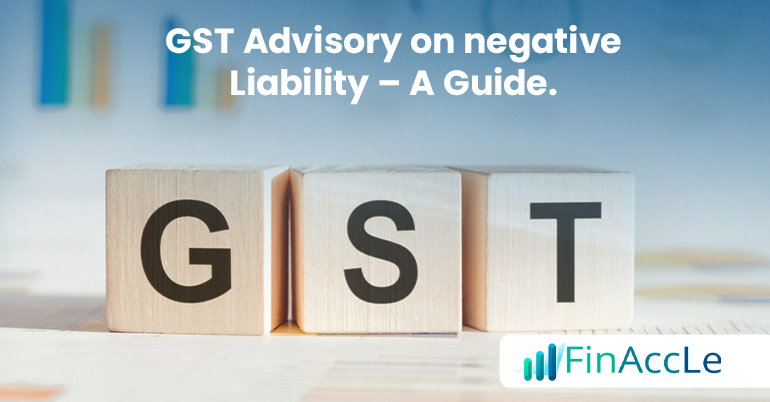
The Goods and Services Tax (GST) system in India is built to streamline indirect taxation. But for many businesses, the compliance process comes with its own complexities — one of which is Negative Liability.
If you’ve filed your returns and noticed a negative figure in your GST liability statement, you’re not alone. Many taxpayers — especially those using PMT-09 or those under the Composition Scheme — face this issue due to errors in tax computation or return filing.
This guide explains what negative liability under GST means, why it occurs, and how you can resolve it with expert guidance.
What is Negative Liability Under GST?
Negative liability in GST occurs when a taxpayer’s tax payable becomes negative, meaning more tax has been credited or adjusted than owed. It typically shows up in the Electronic Liability Register (PMT-01) on the GST portal.
It’s important to note: negative liability does not mean a refund. Instead, it points to an adjustment or misstatement that needs correction.
Common Causes of Negative Liability
There are several reasons this may happen, including:
1. Over-reporting in Previous Periods
If a taxpayer over-reported their outward supplies in a prior return and later corrected it, the revised figures may reflect a negative balance.
2. Incorrect Use of PMT-09
PMT-09 allows shifting of balances from one head (like CGST or SGST) to another. Errors while doing this can result in negative liability in the wrong head.
3. Mistaken Return Filing (CMP-08 vs GSTR-4)
Taxpayers under the Composition Scheme sometimes mistakenly file both CMP-08 and GSTR-4, causing a mismatch and negative tax liability.
4. Duplicate Payment Adjustments
Making a payment and then adjusting it incorrectly in the next return can result in a negative figure in your liability register.
Impact of Negative Liability
Although it may not directly result in penalties, negative liability can:
- Trigger a GSTN system error
- Block Input Tax Credit (ITC) adjustments
- Lead to confusion in future filings
- Cause delays in refunds
- Attract notices from the GST department
That’s why resolving it promptly is essential.
How to Resolve Negative Liability in GST
Here are the steps you should take to identify and correct negative liability:
Step 1: Review Electronic Liability Register (PMT-01)
Go to the GST portal, log in, and navigate to Services → Ledgers → Electronic Liability Register.
Check:
- Transaction type
- Tax period
- Description
- Amounts (positive or negative)
Step 2: Check Filed Returns
Verify if:
- You’ve filed CMP-08 and GSTR-4 correctly
- You’ve reversed any outward supply wrongly reported
- Adjustments using PMT-09 were proper
Download your filed returns and compare with your books.
Step 3: Reconcile ITC and Payments
Make sure your Input Tax Credit and cash payments match the system records. Reconciliation helps identify misstatements and unmatched credits.
Step 4: Use PMT-09 Cautiously
PMT-09 is useful to shift balances across tax heads, but any error while using it can complicate your ledger further. Always double-check before submitting.
Don’t risk getting it wrong — Book GST Advisory with Finaccle for professional help.
Step 5: Contact Jurisdictional Officer
If the issue doesn’t resolve on your end, reach out to your jurisdictional GST officer with all relevant documentation and an application for correction.
Step 6: Avoid Repeating Mistakes
Set up internal compliance checks, review data before filing, and if needed, appoint a professional GST advisor to avoid errors going forward.
GST Composition Taxpayers and Negative Liability
Composition Scheme dealers are more prone to this issue due to the quarterly filing system and return simplification.
Common error: Filing both GSTR-4 Annual Return and CMP-08 for the same period.
To avoid this:
- File only CMP-08 quarterly and GSTR-4 annually
- Do not duplicate your liability
- Reconcile each quarter with annual data
Can Negative Liability Be Refunded?
Short answer: No
Negative liability is not considered a refundable excess. Instead, it is an adjustment of entries within the GST system. However, if you’ve overpaid taxes due to calculation errors, a separate refund application must be filed under RFD-01.
Best Practices to Avoid Negative Liability
Here’s how businesses can prevent this issue:
- Hire GST experts for regular filings
- Use proper accounting and GST filing software
- Reconcile sales & ITC monthly
- Do not file duplicate returns
- Avoid blind usage of PMT-09 without advisory
Case Study: How Finaccle Helped a Client Resolve Negative Liability
Client: Small wholesaler from Surat under Composition Scheme
Issue: Negative liability of ₹20,000 appeared due to double filing of CMP-08 and GSTR-4
Solution:
- Reviewed all filings
- Found duplicate liability
- Submitted a clarification to the jurisdictional officer
- Adjusted ledger using PMT-09
- Educated client on proper compliance
Result: Negative balance cleared. No penalty imposed. Compliance improved.
Want similar support? Connect with Finaccle
Frequently Asked Questions (FAQs)
Q1. What does a negative liability in GST mean?
It means the system reflects more tax paid/adjusted than owed, typically due to filing or payment errors.
Q2. Can negative liability be adjusted in future periods?
Generally, yes — it is auto-adjusted by the system, but clarity and accuracy are crucial to prevent mismatch.
Q3. Will negative liability attract a notice from GST department?
Possibly, especially if the figures look suspicious or indicate consistent over-reporting or misreporting.
Q4. Can I fix negative liability on my own?
You can try, but it’s advised to consult professionals like Finaccle for correct resolution.
Conclusion: Don’t Ignore Negative Liability
Negative liability under GST may seem like a small technical glitch, but left uncorrected, it can spiral into compliance complications, cash flow problems, and notices.
The best approach? Be proactive. Keep your filings clean. Reconcile regularly. And most importantly, get expert support when needed.
Need GST Advisory? Finaccle is Here to Help
At Finaccle, we specialize in:
- GST registration
- Monthly & annual return filing
- Negative liability correction
- Compliance audits
- ITC matching & reconciliation
We serve startups, MSMEs, and established businesses across India.

